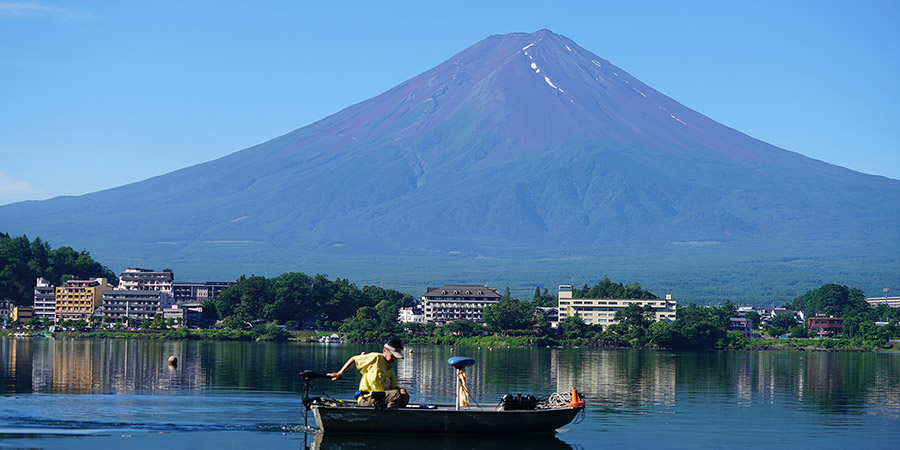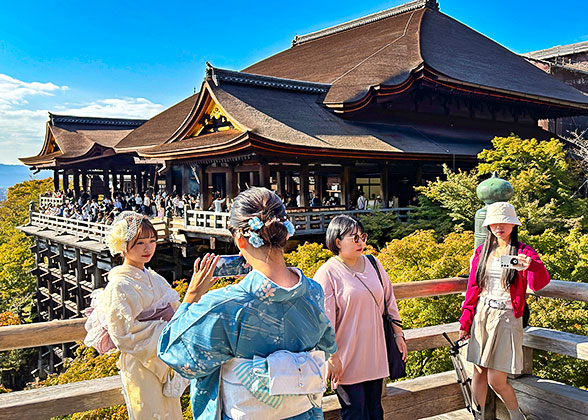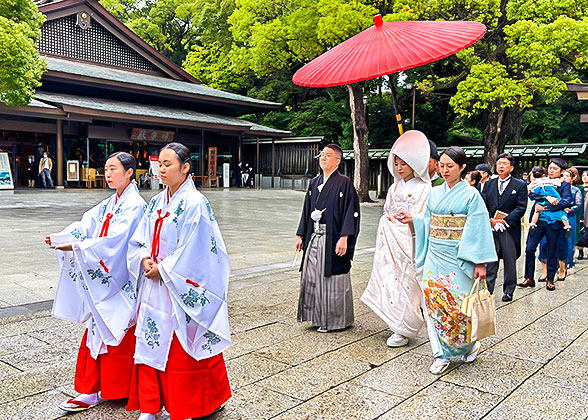Can You Still Climb Mt. Fuji Now?
Only in the climbing season (early July to early September), you can hike to the summit of Mt. Fuji from the 5th Station as making a reservation before your hiking.

Mount Fuji faraway
|
When to Climb Mt. Fuji
In early July every year, around July 10th, the trails to the crater would be opened. Nevertheless, the most popular Yoshida Trail would be opened about 10 days earlier. In the following two months, mountaineers could challenge to the summit of Mt. Fuji. That is, the climbing season is from early July to early September. The climbing trails are closed in the rest time of the year.

Lake Kawaguchi in Autunm
|
In particular, late July to late August is the most popular time for climbing Mt. Fuji. Because the rainy season continues until mid-late July in Japan, and the typhoon peak season comes as early as in late August.
Mountaineering Trails on Mt. Fuji
There are 4 major trails to reach the summit, in different directions of the mountain. After reaching the summit, hikers can also walk along the ring route, called Ohachi-meguri Trail, to go around the crater, which may take 1.5 hours.1. Yoshida Trail – The Most Popular & Low Difficulty
Yoshida trail is the most popular of the four routes, with several times the number of mountaineers on other trails. Relatively, it is the easiest route to climb Mt. Fuji and has the most facilities along the way. Every 1-1.5h, you could meet the facilities like first aid stations, vending machines and huts. Rented safety helmets are offered, and each hut has pay toilets. Moreover, Yoshida Trail is probably opened a few days earlier, which may be on July 1st. Above the 8th Station, Yoshida Trail shares the same route with Subashiri Trail, so it’s more crowded to the summit.
![]() In accordance with the latest regulations, climbers should book the admission ticket in advance. To prevent overcrowding, the number of mountaineers is limited to 4,000 every day at most. When the number of climbers to reserve reaches 4,000, the reservation system of that day will be closed.
In accordance with the latest regulations, climbers should book the admission ticket in advance. To prevent overcrowding, the number of mountaineers is limited to 4,000 every day at most. When the number of climbers to reserve reaches 4,000, the reservation system of that day will be closed.
|
|
|
2. Fujinomiya Trail – Shortest Trail
Fujinomiya Trail is the second most popular route on Mt. Fuji. Although the climbing distance is short, it has a challenging slope and many rocky sections. As it is a popular route, there are many huts and facilities available along the way. At some times during the climbing season (maybe from late July to August), there is also a doctor on duty 24 hours a day at the first aid station of the 8th Station.
3. Subashiri Trail – Plants Viewing

Mount Fuji in summer
|
Subashiri Trail blazed in the woods is worth a try, but it’s more suitable for practiced mountaineers and hikers and those who want to avoid the crowds. Although plenty of trees can shade the sunlight, you will encounter a relatively poor light field of view. The famous volcanic sand section and the sloping rocky trail to slide down are in the higher difficulty. Above it meets Yoshida Trail, there would be more people especially the time to see sunrise.
4. Gotemba Trail – Longest & Most Difficult
Gotemba Trail has the gentlest slope and the least climbers among the four routes, so it is the least crowded. If you want to climb Mt. Fuji without crowds, the Gotemba trail is the best choice. However, it is the longest trail away from the summit with many slopes, which makes it quite difficult to go forward. Only a few shrub-like patches of vegetation grow in the open space of black volcanic sands along the trail.
What to Wear & Bring when Climbing Mt. Fuji
Climbing season is the hottest period in the year, even so the temperature might drop to 5 or 6℃ (41-43℉) on the summit. The higher the place, the lower the temperature. Therefore, clothes to keep warm are the must. As long as you feel chilly, add a thick top. Thus, comfortable hiking shoes, windbreaker, hat, coat, quick-drying underwear, dust protecting mask, and even raincoat should be packed. It is recommended to wear high hiking boots that are not easy to make sands and gravels into the shoes.

Climbers wearing sneakers
|
The headlamp is necessary if you are going to climb Mt. Fuji at night. A flashlight is also optional.
A safety helmet and hiking pole would be helpful while mountaineering. These can be taken beforehand, otherwise you can buy or rent one on the spot.
Other items, including sunscreen, water, and caloric supplement food like chocolate, can be carried according to the physical conditions of your own.
As going to the toilet requires a toilet cleaning fee on Mt. Fuji and only cash is accepted, do take some Japanese coins of 100, 200, or 300 yen when climbing the mountain.
You can take garbage bags to carry out the garbage when climbing.
Regulations for Climbing Mt. Fuji
![]() If you have made a reservation for the hut on Mt. Fuji beforehand, you may be allowed to get onto the trails after 16:00 with the reservation documents. However, it's advised to reach the gates before 16:00 best.
If you have made a reservation for the hut on Mt. Fuji beforehand, you may be allowed to get onto the trails after 16:00 with the reservation documents. However, it's advised to reach the gates before 16:00 best.
![]() People who would like to climb the three trails in Shizuoka Pref. are required to register in advance via the official channel. You could find the QR codes and the link for registration on the official website of Mt. Fuji Climbing.
People who would like to climb the three trails in Shizuoka Pref. are required to register in advance via the official channel. You could find the QR codes and the link for registration on the official website of Mt. Fuji Climbing.
![]() Don’t deface on Mt. Fuji.
Don’t deface on Mt. Fuji.
![]() No camping, no cycling, and no motorcycling on Mt. Fuji.
No camping, no cycling, and no motorcycling on Mt. Fuji.
![]() It’s forbidden to take any plant, rock, or sands away.
It’s forbidden to take any plant, rock, or sands away.
![]() Don’t catch any animal or creature on Mt. Fuji.
Don’t catch any animal or creature on Mt. Fuji.
![]() Don’t bring a pet when climbing.
Don’t bring a pet when climbing.
![]() All personal garbage should be taken away.
All personal garbage should be taken away.
![]() Don’t deviate from the trails.
Don’t deviate from the trails.
Tips
![]() Please make a well-prepared plan before mountaineering.
Please make a well-prepared plan before mountaineering.
![]() A reservation is required to get accommodation in the huts on Mt. Fuji, especially there would be large flow of visitors on weekends and holidays.
A reservation is required to get accommodation in the huts on Mt. Fuji, especially there would be large flow of visitors on weekends and holidays.
![]() Keep up with the team if you climb in a group, and set up the gathering site, time, and emergency contact information in advance.
Keep up with the team if you climb in a group, and set up the gathering site, time, and emergency contact information in advance.
![]() To avoid altitude sickness, take a rest, climb slowly, drink water, take deep breath, etc. if you feel somewhat uncomfortable. If you feel ill indeed, stop climbing immediately and go down the mountain.
To avoid altitude sickness, take a rest, climb slowly, drink water, take deep breath, etc. if you feel somewhat uncomfortable. If you feel ill indeed, stop climbing immediately and go down the mountain.
![]() Pay close attention to your own safety while climbing.
Pay close attention to your own safety while climbing.
![]() Watch the information about local weather and geologic activities before mountaineering, and learn sufficient knowledge to handle the emergency circumstances in case.
Watch the information about local weather and geologic activities before mountaineering, and learn sufficient knowledge to handle the emergency circumstances in case.




